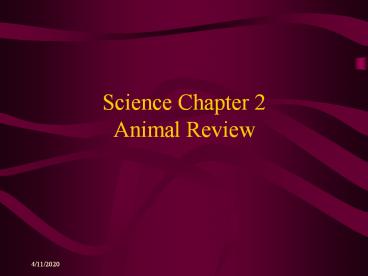Science Chapter 2 Animal Review - PowerPoint PPT Presentation
1 / 36
Title: Science Chapter 2 Animal Review
1
Science Chapter 2 Animal Review
2
The five basic needs of animals are
- Air
- Water
- Food
- Shelter
- Space
3
In your mind, choose two animals.
- What adaptations do these animals possess?
- Is each animals adaptation an adaptation for
growth and development, survival or reproduction?
4
My First Pick
- A polar bear has thick white fur to keep it warm
(purpose survival). Its fur also helps it to
blend in with its artic environment (purpose
camouflage for survival).
5
My Second Choice
- The bright red body of a male cardinal helps it
attract a mate (purpose reproduction). In
other animals, bright colors tell predators to
stay away. They have learned the animal is
poisonous!
6
What is an organism?
- An organism is any living thing.
7
What animal only eats plants and vegetation?
- A herbivore
8
What animal only eats meat?
- A carnivore
9
What animal eats both the meat from other animals
and plants?
- An omnivore
10
What is an animal called that hunts for its food?
- A predator
11
An animal that is food for a predator is called
- prey
12
A ________ is an organism that makes its own food.
- producer
13
What is a consumer?
- A consumer is an organism that eats a producer or
another consumer in a food chain.
14
A _________ is an animal that eats dead animals
that it does not kill.
- scavenger
15
What is a decomposer?
- A decomposer breaks down the remains of once
living materials.
16
Mild Forest Ecosystem Food ChainIf one of these
organisms were taken out, how would this affect
the rest of the food chain?
17
What is an example of an inherited trait?
- Eye color
- Hair color
18
Learned behaviors are behaviors that animals
learn through experience. Give an example of a
learned behavior.
- Language
- Animals hunting for food
- A dog doing tricks
19
Instinctive behaviors are patterns of behavior
that are automatic. Give an example of an
instinctive behavior.
- A Spider spinning a web.
- Migration
- Baby sea turtles going to the sea.
20
What is an inherited behavior?
- An inherited behavior is much like a reflex. It
is a behavior that is inherited from our parents,
such as scratching an itch or crying.
21
What is a metamorphosis?
- A change in body form.
22
List the steps of a complete metamorphosis.
- Egg
- Larva
- Pupa
- Adult
23
List the steps of an incomplete metamorphosis.
- Egg
- Nymph
- Adult
24
Life Cycle of a chicken
25
What is a vertebrate?
- A vertebrate is an animal with a backbone.
26
What is an invertebrate?
- An invertebrate is an animal without a backbone.
27
What are the characteristics of a fish? Identify
one animal in this class.
- Lives in water
- Breathes through gills
- Has a backbone
- Covered with scales
- Cold-blooded
28
What are the characteristics of amphibians? List
one animal in this class.
- Lives part of life in water and part of life on
land. - Cold-blooded
- Has a backbone
- Has smooth, moist skin and no scales
- Usually goes through a metamorphosis
29
What are the characteristics of reptiles? List
one animal in this class.
- Dry, rough, scaly skin
- Has lungs for breathing
- Cold-blooded
- Has a backbone
- Most hatch from eggs
30
What are the characteristics of birds? List one
example of an animal in this class.
- Has feathers
- Warm-blooded
- Hatches from an egg
- Has a backbone
- Has a beak
- Has two legs and two wings.
31
What are the characteristics of mammals? List
one animal in this class.
- Babies are fed with milk from the mothers body
- Has a backbone
- Has a well-developed brain
- Warm-blooded
- Has fur or hair
32
Identify one environmental change and describe
how this change could either be beneficial or
harmful to the ecosystem.
- Fire can be both beneficial and harmful. Fire can
destroy our land and animals habitats but it can
also clear away dead or diseased plants and brush
to make new room for organisms to grow.
33
Identify one environmental change that can be
caused by humans.
- Fire
- Construction
34
List three differences between an insect and an
arachnid and one thing these organisms have in
common.
- Differences insects have 6 legs and arachnids
have 8, insects have 3 body parts and arachnids
have only 2 body parts and insects can fly and
arachnids can not fly - Common they are both invertebrates
35
List three differences between a reptile and an
amphibian and two things these organisms have in
common.
- Differences reptiles have dry, rough, scaly
skin and amphibians have smooth moist skin,
reptile babies look like smaller copies of their
parents and most amphibians go through a
metamorphosis, and amphibians have gills part of
their lives and lungs the other part of their
lives, reptiles breathe through lungs all their
lives. - Common they are both cold-blooded vertebrates
36
Good luck on your test! Be sure to study, study,
study!































